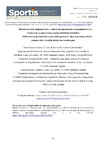Diferencias en la condición física y valores antropométricos en alumnado de 11 y 12 años tras un plan de intervención de hábitos saludables

Use este enlace para citar
http://hdl.handle.net/2183/33066
A non ser que se indique outra cousa, a licenza do ítem descríbese como Attribution-NonCommercial-ShareAlike 4.0 International (CC BY-NC-SA 4.0)
Coleccións
Metadatos
Mostrar o rexistro completo do ítemTítulo
Diferencias en la condición física y valores antropométricos en alumnado de 11 y 12 años tras un plan de intervención de hábitos saludablesTítulo(s) alternativo(s)
Differences in physical fitness and anthropometric values in primary school students after a healthy habits intervention planData
2023-05-01Cita bibliográfica
Ramos-Álvarez, O.; Puente León, A.; Arufe Giráldez, V. (2023). Diferencias en la condición física y valores antropométricos en alumnado de 11 y 12 años tras un plan de intervención de hábitos saludables. Sportis Sci J, 9 (2), 237-261
Resumo
[Abstract] At the primary school stage, especially in the last cycle, it can be observed more and more frequently that pupils are changing their routines and activities towards other more sedentary activities. This development may be a source of non-communicable diseases (NCDs). The increase in time spent using screen devices is to the detriment of time devoted to physical activity. It is for this reason that the area of Physical Education takes on the responsibility of
promoting the practice of physical activity and an improvement in the eating habits of students. This quasi-experimental research is an intervention with an experimental group and subsequent analysis of the results with those obtained by a control group. The aim of the study is to check if there are differences in the physical condition and anthropometric values of 11 and 12 year old students after an intervention plan at school on their healthy habits. For this purpose, the Alpha Fitness Test Battery and a daily food control were used. The results show that after implementing the healthy habits programme, the time dedicated to physical activity and the acquisition of a healthy diet increased, improving the results of physical
condition assessment as well as anthropometric values. [Resumen] En la etapa de Educación Primaria, sobre todo en el último ciclo, se puede observar cada vez con más frecuencia que el alumnado va cambiando sus rutinas y actividades hacia otras actividades de carácter más sedentario. Este acontecimiento, puede ser origen de enfermedades no transmisibles (ENT). El incremento del tiempo destinado al uso de dispositivos con pantalla se produce en detrimento del tiempo dedicado a la práctica de actividad física. Es por ello por lo que desde el área de Educación Física se adquiere la responsabilidad de promover la práctica de actividad física y una mejora en los hábitos alimentarios del alumnado. Esta investigación cuasiexperimental es una intervención con un grupo experimental y su posterior análisis de resultados con los obtenidos por un grupo de control. El objetivo del estudio es comprobar si existen diferencias en la condición física y valores antropométricos en alumnado de 11 y 12 años tras un plan de intervención en la escuela sobre sus hábitos saludables. Para ello, se utiliza la Batería de pruebas Alpha Fitness y un control de comidas diarias. Los resultados muestran que tras implementar el programa de hábitos saludables se incrementó el tiempo dedicado a la actividad física y la adquisición de una dieta saludable mejorando los resultados de valoración de la condición física, así como de los valores antropométricos.
Palabras chave
Actividad física
Sedentarismo
Niños
Salud
Nutrición
Pphysical activity
Sedentary lifestyle
Children
Health
Nutrition
Sedentarismo
Niños
Salud
Nutrición
Pphysical activity
Sedentary lifestyle
Children
Health
Nutrition
Versión do editor
Dereitos
Attribution-NonCommercial-ShareAlike 4.0 International (CC BY-NC-SA 4.0)






